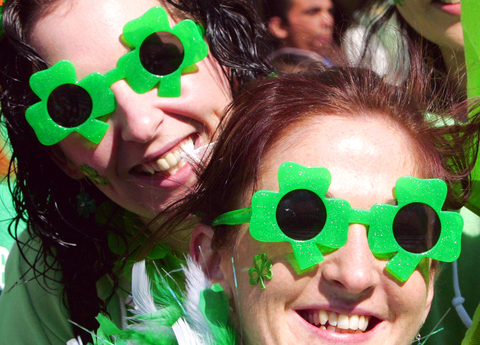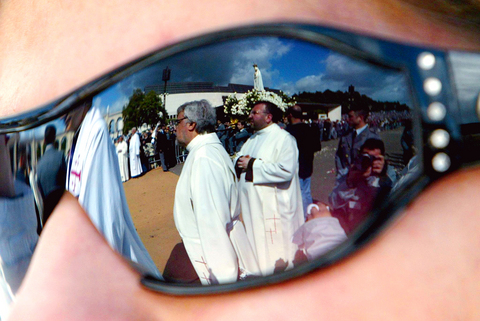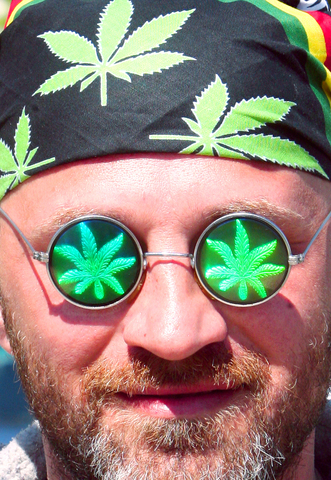Bono has a party trick. When anyone asks the U2 singer why he insists on always wearing his signature, blue-tinged sunglasses (you know, the wraparound Chanel jobs permanently clamped on to his front-of-house, the ones that replaced the Cutler and Gross "fly's eyes" model he wore circa Achtung Baby) he will explain, with refreshing honesty, that his shades actually provide a kind of instant stellar petrification. That without them on, he just looks like an ordinary little Irish man. "Look," he will say lifting them on and off, up and down, "rock star with them on ... ordinary bloke without them. Rock star/ordinary bloke, rock star/ordinary bloke ..."
Truth is, we are all a little bit Bono in the face furniture department these days. Look around you and you will see that wearing sunglasses all year round, summer and winter, sunshine and rain, inside and outside, on your face or even on top of your head, is not quite the gauche, self-regarding faux pas it used to be.
Why not? Of all the weapons in the fashion accessory arsenal, sunglasses are the most pretentious and unnecessary. It could be argued that global warming and more sunshine have helped turn us into a shaded nation. But their original, practical applications are long forgotten. Sunglasses have nothing to do with protecting our eyes from the sun's harmful rays and are all about creating an image, a kind of instant glamourflage in the nasty outside world. Yes, we put on a pair of shades when the sun comes out but, at the fashion end of the spectrum, we will also put them on to make a statement.

PHOTOS: AGENCIES
Without our sunglasses we are ordinary Joes/Janes, but just buy a pair of, say, knock-off Ray-Ban aviators from H&M and suddenly a transformation occurs; we become stars in our own private magazine drama. Instead of being dreary civilians, we are important/glamorous/famous/tortured/jetlagged/wasted/mysterious/ wronged/hungover/officious/dodgy/grieving/heartbroken/pleading not guilty, etc.
Among the Hello!stocracy, sunglasses have become a serious addiction, a can't-leave-the-house-without-them essential on a par with credit cards and mobile phones. I first became aware of this back in the late 1990s when I went round to Liam Gallagher and Patsy Kensit's north London house to do an interview. By the front door, in a shallow tray, where the rest of us keep our car keys, the dog lead and a stack of unopened windowpane letters from the tax man, Mr and Mrs Cool Britannia had about 50 pairs of designer shades ready to put on whenever they left the house. I am sure they would have maintained that the strobing paparazzi flashes that they experienced every time they left the house would have hurt their eyes, but you also got the impression they knew that, without them, Kensit would have been just an actor with a husky voice and Liam a beery bloke from Manchester in an anorak.
The permanently shaded state is now a global aspiration endorsed by the skinny, pie-eyed, knickerless characters who inhabit gossip magazines and tabloids. Paris Hilton, a woman whose whole life is always tinted by sunglasses or blacked-out limo glass (or just the all-pervading fug of simple-minded vacuity), wears those big Sunny Mann-redux glasses that render her a turbo-famous rich bitch and timorous meerkat all at the same time. She wears them for court appearances, parties and red-carpet events.

On size 00 girls such as Posh, Paris and Nicole Ritchie, oversize sunglasses have a slightly disturbing, disproportionalizing, head-shrinking, infantilizing effect on their faces, making them look like little kids. Posh thinks she looks cool in her big Dior shades. I think she looks like a seven-year-old dressed up as a Power Ranger.
Add to the mix a few shots of Botox to the forehead, lips overblown and rendered immovable by repeated shots of collagen, a floppy curtain of hair extensions and you have a person no more capable of facial expressions than if they were manufactured by Mattel.
While we are not all such tragic victims of optical delusion, most of us cannot do with just one pair either. Our collections will comprise classics, sporty numbers and designer names. Some of us buy four pairs a year, knowing that even though they cost anything up to NT$15,000 a pop, they are fragile, disposable items with a limited face/fashion/shelf life and we'll be losing them/sitting on them/leaving them in the airport on a regular basis. All of which, of course, is great news for the booming sunglasses trade.

You think "It" bags and the new season's "must-have" shoes are big business? They are mere minnows compared to the market for shades. The Milan-based Luxottica group, the sunglasses behemoth that owns Ray-Ban, Arnette, Persol, Bausch and Lombe, Sunglasses Hut and Lenscrafters and also makes sunglasses under license for Ralph Lauren, Bulgari, Burberry, Chanel, D&G, Dolce & Gabbana, DKNY, Ferragamo, Miu Miu, Prada, Versace and Versus, has a rolling, combined collection of more than 2,650 models, creating more than 800 new styles every year.
Tony Gross, of the London-based optician and sunglasses manufacturer Cutler and Gross, has been setting trends and serving celebs from his little boutique on Knightsbridge Green since the 1970s, "when, really, you could only sell sunglasses to old people who were worried about damaging their eyes. And most of the styles were just awful. Very unflattering." Gross recalls a time when sunglasses were more of a distress purchase than a multiple-buy fashion essential, when the average person dug out a trusty pair of faux tortoiseshell Foster Grants, bought off one of those rickety, rotating wire display units in high street chain stores, and kidded himself that he was a holidaying Vitas Gerulaitis (or Joan Collins in Nina Riccis) for the next few months. "You couldn't sell sunglasses during the winter," recalls Gross. "And a bad summer would be bad for business. Now it makes next to no difference."
The big change came during the go-getting, spend, spend, spend 1980s. "In 1983, Tom Cruise wore Ray-Ban Wayfarers in Risky Business and a company that everyone had forgotten about was suddenly famous again. Everybody wanted Wayfarers and they were prepared to pay for them." Feeling confident and trading on his reputation as both designer and qualified optician, Gross — who has made many of Elton John's outlandish specs and now runs a rather fabulous vintage sunglasses shop a few doors from his original retailer — put his first pair of NT$6,000-plus glasses on the shop shelf. "I think I was instrumental in making sunglasses an event, a fashion 'look' in themselves," he says. Gross never looked back and the sunglasses trade has been dazzling the markets ever since.
So which particular sunglasses should you be wearing on the beach and at your desk this summer? In London's fashionable Shoreditch, those Ray-Ban Wayfarers as worn by Tom Cruise in the 1980s are making a big comeback. Charlie Porter, associate editor of GQ, recommends men ditch the old standby aviator style for more severe, thick-rimmed design.
But are you really allowed to wear sunglasses indoors? Apparently so. At the London Guardian newspaper's fashion department there have been recent reports of a nu-rave intern who wore her glasses to work every day, through cloudy and sunny days alike. She politely observed office convention and took off her big, white-framed glasses at her computer terminal, but popped them on for every visit to the water cooler, the kettle, photo copier and the toilet. Did people laugh at her, your reporter asked. "Oh no," said fashion editor Jess Cartner-Morley. "We all thought it was fabulous."

On April 26, The Lancet published a letter from two doctors at Taichung-based China Medical University Hospital (CMUH) warning that “Taiwan’s Health Care System is on the Brink of Collapse.” The authors said that “Years of policy inaction and mismanagement of resources have led to the National Health Insurance system operating under unsustainable conditions.” The pushback was immediate. Errors in the paper were quickly identified and publicized, to discredit the authors (the hospital apologized). CNA reported that CMUH said the letter described Taiwan in 2021 as having 62 nurses per 10,000 people, when the correct number was 78 nurses per 10,000

As we live longer, our risk of cognitive impairment is increasing. How can we delay the onset of symptoms? Do we have to give up every indulgence or can small changes make a difference? We asked neurologists for tips on how to keep our brains healthy for life. TAKE CARE OF YOUR HEALTH “All of the sensible things that apply to bodily health apply to brain health,” says Suzanne O’Sullivan, a consultant in neurology at the National Hospital for Neurology and Neurosurgery in London, and the author of The Age of Diagnosis. “When you’re 20, you can get away with absolute

May 5 to May 11 What started out as friction between Taiwanese students at Taichung First High School and a Japanese head cook escalated dramatically over the first two weeks of May 1927. It began on April 30 when the cook’s wife knew that lotus starch used in that night’s dinner had rat feces in it, but failed to inform staff until the meal was already prepared. The students believed that her silence was intentional, and filed a complaint. The school’s Japanese administrators sided with the cook’s family, dismissing the students as troublemakers and clamping down on their freedoms — with

As Donald Trump’s executive order in March led to the shuttering of Voice of America (VOA) — the global broadcaster whose roots date back to the fight against Nazi propaganda — he quickly attracted support from figures not used to aligning themselves with any US administration. Trump had ordered the US Agency for Global Media, the federal agency that funds VOA and other groups promoting independent journalism overseas, to be “eliminated to the maximum extent consistent with applicable law.” The decision suddenly halted programming in 49 languages to more than 425 million people. In Moscow, Margarita Simonyan, the hardline editor-in-chief of the